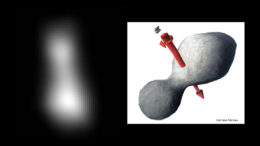What did you do on New Year’s Eve this year? Whatever it was, it probably wasn’t quite as extreme as what the New Horizons spacecraft was doing: passing by 2014 MU69 in the most distant flyby of any object in our solar system.
Today, we’ll get our first detailed look at 2014 MU69 — nicknamed Ultima Thule — from high-resolution data arriving from New Horizons. But while we wait, we can take a moment to explore what we’ve already learned about this small body in our outer solar system.
A Distant Target

A first, low-resolution image of Ultima Thule from New Horizons, taken on 31 Dec 2018, just before the spacecraft’s closest approach. The right inset shows an artist’s sketch of Ultima Thule’s possible shape. [NASA/JHUAPL/SwRI; James Tuttle Keane]
Why fly by Ultima Thule? This target offered a rare opportunity to learn more about the geology and morphology of objects in our outer solar system. In particular, scientists hoped to learn about its surface composition, its structure, and whether it hosts moonlets, a coma, or rings.
But flyby data from New Horizons is not the only means we have of observing such distant bodies — and almost as soon as the target was selected, stalking of Ultima Thule began. Through what are known as occultation observations, scientists have already learned quite a bit about the previously unknown 2014 MU69.

As 2014 MU69 — Ultima Thule — passes in front of a background star, this occultation can be observed from Earth with carefully placed lines of ground telescopes or with SOFIA, an airborne observatory. [NASA]
Stalking Occultations
In a recently published study led by Eliot Young (Southwest Research Institute), a team of scientists detailed their search for evidence of rings around Ultima Thule using occultation observations.
Young and collaborators explored data obtained on three dates in the summer of 2017: on 3 June, from South Africa and Argentina, on 10 June, from the airborne observatory SOFIA, and on 17 July, from Argentina. On these days, telescopes were assembled with the goal of catching 2014 MU69 as it crossed in front of a background star, briefly blocking the star’s light.
The light curves produced by these occultations allowed the team to explore whether Ultima Thule is encircled by additionally light-blocking rings.
Ruling Out Rings

An example of candidate rings (red ellipses) ruled out by occultation observations on 17 July 2018 (yellow lines and map in the right panel). [Young et al. 2018]
The result? Ultima Thule seems highly unlikely to host any rings: rings with radii up to 1,000 km and radial widths of ~720 meters are inconsistent with the occultation light curves, and any ring larger than 1,000 km in radius would produce enough light to have been detected in Hubble Space Telescope imaging.
So far, this apparent lack of rings is consistent with the low-resolution images we’ve received from New Horizons’s flyby. Today — and in the months to come — we’ll find out what is revealed in higher resolution images and data. As always, it’s exciting to watch science in action!
Citation
“Limits on a Ring System at 2014 MU69 from Recent Stellar Occultations,” Eliot F. Young et al 2018 Res. Notes AAS 2 224. doi:10.3847/2515-5172/aaf574


3 Comments
Pingback: Este es 2014 MU69. | Pablo Della Paolera
Pingback: AAS Nova – New
Pingback: January 1 – January 6, 2019 | Colorado Space News